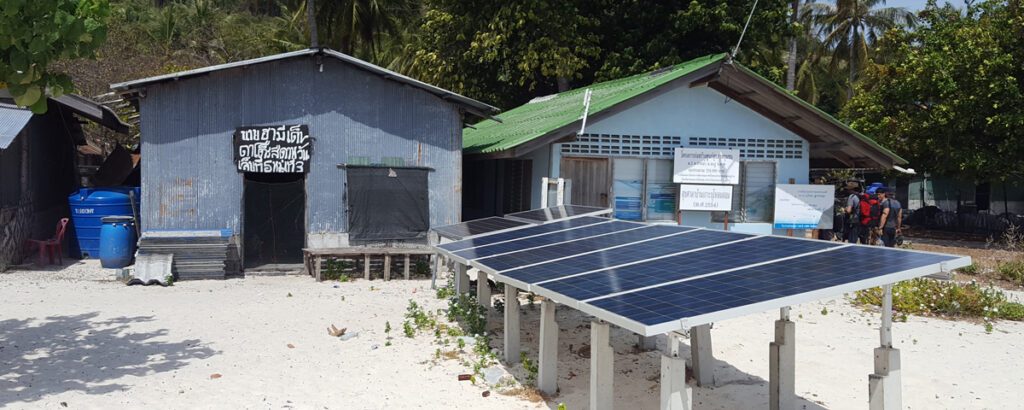Climate resilience for island communities in Southeast Asia

Project description
Southeast Asia is one of the regions most affected by the impacts of climate change. This is particularly true for remote communities on the numerous small islands in the region, underscoring the urgency of building climate change resilience for these remote island communities. In addition, these island communities face the problem of limited and unreliable electricity supply. Access to electricity is a prerequisite for many adaptation measures and thus has the potential to help Southeast Asian island communities improve their resilience.
Surprisingly, both aspects – electricity access and climate resilience – are rarely linked in current energy planning for these island communities. Energy planning in a region highly affected by climate change requires integrated and multidimensional approaches that take these risks into account.
Research uses holistic approach
Thus, this research aims to enable climate-resilient planning of off-grid energy systems to support the island communities’ adaptation efforts. It develops and applies an initial and holistic approach towards climate resilient energy system planning building on literature review, data analysis (R, QGIS), and empirical research (expert interviews).
Methodology combines a risk analysis of the climate and modeling of energy systems
First, (i) a climate change risk assessment for Southeast Asian islands is conducted. Based on these results, (ii) a resilient energy system modelling approach based on HOMER and an Excel cash flow model is developed considering site-specific adaptation measures and applied to three representative case study islands.
This research provides an initial overview of the potential benefits and applicability of resilient energy system planning for areas threatened by climate change and offers an approach to integrating climate change risk analysis into energy system planning. The results highlight the importance of climate risk assessment and resilient energy system planning for climate change threatened regions such as Southeast Asia. The developed approach improves the long-term energy reliability of Southeast Asian island communities and increases their resilience in the face of the intertwined climate and energy challenges.
Project Duration October 2018 – January 2022
Tasks
Based on the literature review, four different climate change-related hazards that affect current and future energy systems are identified:
- temperature increase,
- fluctuation in precipitation patterns (leading to floods and droughts),
- sea-level rise, and
- extreme weather events (e.g. cyclones).
The climate change risk assessment reveals significant frequency and severity of these risks to Southeast Asian islands, their communities, and (future) energy systems. Climate change hazards vary across the region, but patterns and characteristics can be identified: There is a strong, geographically attributable risk for cyclones, a high risk for sea-level rise for smaller islands (resulting in a higher proportion of land loss), and a higher risk of flooding for islands outside the tropical climate classification (Köppen-Geiger). Furthermore, site-specific climate change risk profiles and scales are developed for all 11,083 analyzed islands.
(ii) Resilient Energy System Modelling:
A list of adaptation measures and associated additional investment costs to reduce site-specific climate risks on off-grid energy systems and climate change-adapted demand structures are the outcome of conducted expert interviews. Technical measures to increase the resilience of island energy systems are manifold and are component- and risk-specific, the extra investment cost to implement these have a range between 2 % and 22 %. These measures can be integrated into common energy system modelling by reflecting their extra investment cost as essential input parameter and considering demand increases of up to 20 % in the planning process.
Various energy modelling scenarios run in HOMER help to map different degrees of climate resilient planning and allow for comparison with common planning approaches (business as usual – BAU) for three case study islands. Evaluation of these scenarios, which simulate different frequencies and severities of climate change induced damage to the energy system, shows that climate-resilient energy system planning is feasible in most cases: Resilient energy system planning is viable for 96 % of all evaluated cases (69 out of 72) if medium to high climate change risks are reflected in resilient energy system planning and 83 % (60 out of 72) if all occurring risks are considered.
The higher the frequency and severity of damages caused by climate change, the more feasible it is to adopt a climate-resilient system planning approach. Higher diesel prices are causing a trend in favor of resilient energy system planning. Resilient power system planning also reduces the probability of power outages due to environmental disturbances and thus minimizes the losses associated with outages.
In conclusion, the integration of climate risk assessments into energy system planning for climate change threatened communities is important. This interdisciplinary approach has proven to give guidance for decision-makers to implement climate resilient energy systems.
